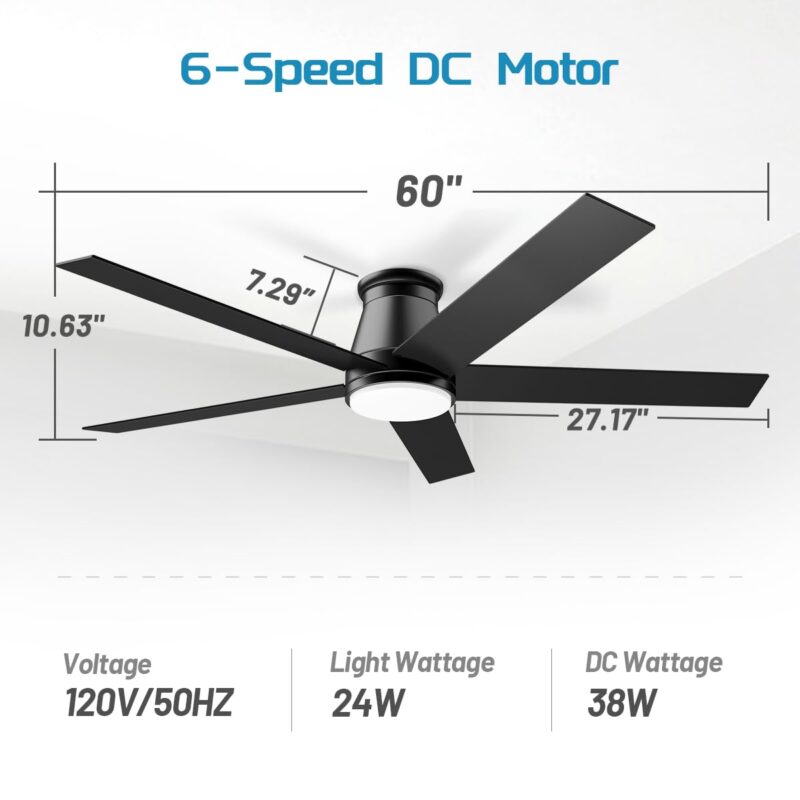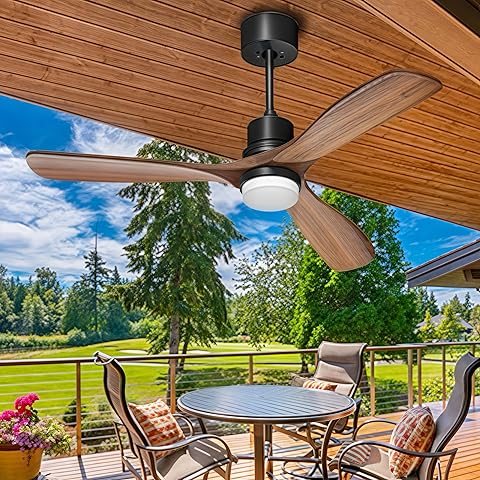Ceiling fans are standard fixtures in homes and businesses, providing a cool breeze and often enhancing the aesthetic of a room. Adding lights to these fans transforms them into multifunctional fixtures, raising questions about energy consumption. For the energy-conscious, Ceiling Fan Wattage: Does adding lights to a ceiling fan significantly increase its wattage consumption? Let’s break this down, exploring the factors influencing wattage, energy-saving techniques, and smart lighting options.

Understanding Ceiling Fan Wattage
Ceiling fans are generally energy-efficient, with wattage usage ranging from 10 to 100 watts depending on their size and speed. However, adding lights to a fan can substantially increase its wattage, depending on the number and type of bulbs used in the light kit.
A Basic Comparison of Ceiling Fan Wattage:
- Without Lights: Most ceiling fans consume 50 to 75 watts at high speed and less at reduced speeds.
- With Lights: Adding traditional high-wattage bulbs like incandescent or CFLs can double or even triple the total energy consumption. Using LED bulbs minimizes the additional wattage significantly.
The Role of Bulb Type in Wattage Consumption
The type of bulb used in the ceiling fan’s light kit directly impacts its overall wattage. Here’s a closer look:
Incandescent Bulbs:
- Wattage: Typically 40 to 100 watts per bulb.
- Example: A fan with four 60-watt bulbs adds 240 watts to the fan’s base consumption.
- Drawback: High energy consumption and a short lifespan.
CFL (Compact Fluorescent Lamps):
- Wattage: 10 to 20 watts per bulb.
- Example: Four 15-watt CFLs add only 60 watts.
- Advantage: More energy-efficient than incandescent bulbs but less so than LEDs.
LED (Light-Emitting Diode) Bulbs:
- Wattage: 4 to 10 watts per bulb.
- Example: Four 10-watt LEDs add a mere 40 watts to the fan’s total consumption.
- Advantage: Extremely energy-efficient, eco-friendly, long-lasting, and cost-effective.
Clearly, LED bulbs are the superior choice for those prioritizing low energy consumption and high illumination.

Wattage Limiters: What Are They and Why Do They Matter?
Many ceiling fans include wattage limiters, which cap the total power of the light kit to meet energy efficiency codes. Typically set at 190 watts or less, these limiters ensure you cannot exceed the allowable wattage without compromising safety and performance.
Key Benefits of Wattage Limiters:
- Prevent overloading the fan’s electrical system.
- Ensure compliance with energy-efficiency standards.
- Encourage users to choose lower-energy lighting options.
Factors Affecting Wattage with Lights
Several factors influence the total wattage of a ceiling fan with lights:
- Number of Bulbs:
- Fans with more bulb sockets will naturally consume more wattage.
- Bulb Wattage:
- Higher wattage bulbs increase overall consumption. Opt for LEDs or other low-wattage options.
- Additional Features:
- Dimmer switches: Allow brightness adjustment, reducing energy usage.
- Smart lighting systems: Optimize energy consumption by automating light usage.
- Fan Motor Efficiency:
- High-efficiency motors paired with LED bulbs result in the lowest overall wattage.
Does Adding Lights to a Ceiling Fan Significantly Increase Wattage?
The answer is yes, but the extent depends on your configuration:
- Significant Increase: Using incandescent or CFL bulbs can double or triple wattage consumption.
- Minimal Increase: Using energy-efficient LEDs results in a negligible increase, often under 50 watts.

Energy-Saving Tips for Ceiling Fans with Lights
To minimize energy consumption when adding lights to your ceiling fan, consider these tips:
- Switch to LED Bulbs:
- LEDs consume up to 85% less energy than incandescent bulbs and last far longer.
- Use Wattage Limiters:
- Ensure your fan’s light kit stays within safe and efficient power limits.
- Install a Dimmer Switch:
- Adjust light levels as needed to save energy when full brightness isn’t necessary.
- Leverage Natural Light:
- Rely on natural light during the day and use ceiling fan lights only when needed.
- Adopt Smart Lighting:
- Connect your ceiling fan lights to a smart system for automated, optimized usage.
Choosing the Right Light Kit and Ceiling Fan
When selecting a ceiling fan and light kit, consider the following factors:
Fan Compatibility:
- Ensure the light kit is compatible with your fan model and supports energy-efficient bulbs.
Room Size:
- Select a fan and light output appropriate for your room size. Larger rooms may require fans with multiple lights.
Design Preferences:
- Opt for light kits that complement your room’s aesthetics while meeting your lighting needs.
Energy Star Certification:
- Look for the Energy Star label for superior energy efficiency.
Common FAQs
1. Does adding lights to a ceiling fan increase running costs?
Yes, but the extent depends on the bulb type and quantity. LEDs cause minimal increases compared to incandescent bulbs.
2. Can all ceiling fans use LED bulbs?
Most modern ceiling fans are compatible with LED bulbs, but check your fan’s specifications to confirm.
3. What is the lifespan of LED bulbs in ceiling fans?
LED bulbs can last up to 25,000 hours, far exceeding the lifespan of incandescent and CFL bulbs.
Why Choose Blowox for Ceiling Fans and Light Kits
At Blowox.com, we prioritize functionality, style, and energy efficiency. Here’s why we stand out:
- LED-Compatible Light Kits: Reduce energy usage and enjoy longer-lasting illumination.
- Modern Designs: Find fans and light kits that suit any interior design.
- Durable Products: Our ceiling fans and mounts are built to last, ensuring long-term value.
Final Thoughts
Adding lights to a ceiling fan does increase wattage, but the extent depends on your choices. Using LED bulbs and smart lighting systems allows you to enjoy enhanced lighting without significantly impacting energy consumption.
Ready to elevate your space with energy-efficient ceiling fans and stylish light kits? Visit Blowox.com today to explore our collection and find the perfect solution for your home or business. Let’s illuminate your world, the smart way! 🌟
Get Expert Advice Right Now by Contacting Us!
- Email: info@blowox.com
- Visit: blowox.com



Top 10 Best Outdoor Patio Ceiling Fans to Beat the Heat in 2025
Having the best outdoor patio ceiling fan will make all the difference in how much [...]
Top 10 Best 3 Blade Ceiling Fans for Modern Homes in 2025
Finding the best 3 blade ceiling fan can transform the ambiance and comfort of your [...]
Reviews, Features, and Shopping Advice for 2025’s Best Modern Ceiling Fans
Modern ceiling fans have evolved from a mere cooling solution to a statement of efficiency [...]
How to Operate a Ceiling Fan: Expert Tricks to Save Money and Stay Cool
More than merely ornamental accents, ceiling fans are reasonably priced means of improving comfort and [...]
Top 10 Cheap Outdoor Ceiling Fans That Offer Style and Durability in 2025
Finding the ideal cheap outdoor ceiling fan does not mean you have to give up [...]
Does Leaving a Ceiling Fan On Waste Electricity? 5 Surprising Facts You Should Know
Many homes find ceiling fans to be the go-to fix for home comfort. Still, a [...]
Does Reversing a Ceiling Fan Make It Warmer? The Winter Home Hack You Need to Know
Homeowners sometimes look for creative solutions to keep their houses comfortable without going broke as [...]
Does Reversing a Ceiling Fan Work? The Winter Energy Hack You Need to Know
Heating bills can explode when temperatures fall. You might be asking: Does reversing a ceiling [...]
Does Running a Ceiling Fan Help with Air Conditioning? 5 Surprising Benefits You Need to Know
Maintaining coolness in your environment may be both a need and a comfort throughout summer. [...]
The Ultimate Guide to Choosing the Best Ceiling Fan for Small Room
Choosing the Best Ceiling Fan for Small Room will revolutionize the comfort and design enhancement [...]